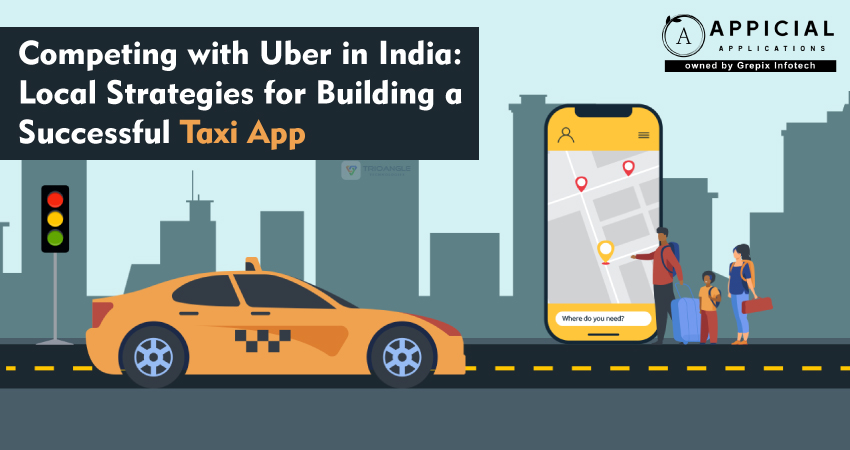
Competing with Uber in India: Local Strategies for Building a Successful Taxi App
Uber may be a global ride-hailing titan, but in India’s dynamic and rapidly growing mobility market, the game is far from over.
With rising urbanization, smartphone penetration, and the booming need for reliable transport in both metros and smaller cities, India presents a unique opportunity for local players to step in and shine.
The real edge lies not in copying Uber—but in doing it better, smarter, and more locally.From navigating tier-2 markets to offering hyperlocal solutions and building with affordability in mind, there's massive potential to build an Uber-like app that outpaces the giants by being more relevant, relatable, and region-specific.
This blog reveals exactly how to carve out your space and win in India’s fiercely competitive taxi app landscape.
India’s ride-hailing industry is booming, with projections soaring from $21 billion in 2025 to over $44 billion by 2032. While Uber leads the game, there’s plenty of room for local players to rise, especially in tier-2 and tier-3 cities. This blog explores how entrepreneurs can build a successful Uber clone by leveraging regional advantages, offering localized services, integrating smart tech, and focusing on affordability and trust. From navigating regulatory hurdles to forming strategic partnerships and adopting EVs, this guide outlines everything you need to compete — and win — in India’s dynamic ride-hailing market.
Compete with Uber in Indian Markets
Uber may be the leader of the game today, but here's the reality: the local players are just waiting for the right moment. India's ride-hailing market is on fire with demand, and this is the best time to enter for smart local players.
The market is only expanding. In fact, the taxi industry in India is projected to increase from $21 billion in 2025 to over $44 billion by 2032. That's an enormous window of opportunity!
Even Uber is experiencing tremendous growth! Its revenue in India rose 41% to ₹3,761 crore in FY24, and it reduced losses by 71%. Obviously, there's money to be made, and space to do it differently. With the right combination of local expertise, more intelligent technology, and a people-first strategy, creating an Uber clone in India can truly take flight.
But this is not about replicating Uber. This is about replicating it better, in the context of what Indian users actually need. So, if you are considering venturing into this space, this article will walk you through how to compete with Uber in India.
Taxi App Competition in India
The ride-hailing in India is no longer just about reaching from point A to point B, it's about convenience, speed, cost, and trust. Although Uber and Ola have been ruling the roost for years, now they're not the only ones people are going for. The newer players in the market are coming up with innovative ideas and local solutions, and they are beginning to make waves.
Companies such as Rapido, BluSmart, Yulu, and Mega Cabs are expanding rapidly by betting on what users actually want, be it electric rides, lower fares, or service improvements. Rapido, for instance, has emerged as a dominant player in bike taxis, particularly in tier 2 and tier 3 cities where giants have limited presence.
For anyone who wants to start a local taxi app, India is a massive opportunity. More and more people are opting for app-based transportation each day, and there is space for innovation. The fuel prices, traffic congestion, and air pollution are all increasing, and customers are opting for taxis over having a personal car. You don't need to be a behemoth to make it. It's all about solving authentic issues, such as waiting times, fare-related issues, or shoddy services in the underserved places.
This is where the idea of an Uber clone in India becomes interesting. Of course, there are challenges. You’ll face tough competition, regulatory hurdles, and the need for strong tech and support systems. But with the right strategy, local knowledge, and focus on quality, a new app can carve out its own space.
Regional Opportunities for Ride-Hailing Services in India
Here's how different regions are creating real opportunities:
Big Cities Are Still Booming
In metro cities like Delhi and Mumbai, there is a very strong and consistent demand for ride-hailing services. Traffic is heavy, and parking is full of headaches. In such cases, hailing ride apps are everyone's preference compared to driving. So, such cities are best to implement features like premium rides, carpooling, or EV fleets.
Tier-2 and Tier-3 Cities Are the Next Big Thing
The economies of cities like Indore, Jaipur, Lucknow, and more are growing fast. More people are entering and settling in them. Additionally, roads are improving than before, and of course, everybody has a smartphone nowadays.
That directly means there's more demand for local travel in these cities. All the big players initially ignored them, but now the local taxi apps are covering that gap and attracting users by catering to the local needs.
Uber’s Expansion Shows the Market Size
Did you know that Uber is now in over 125 Indian cities? That clearly shows how much potential lies beyond the metros. They’ve already done the homework, now it’s your turn to do it better, especially with a strong local focus.
Localized Services Win Hearts
Smaller city customers do not necessarily need luxurious rides. What they seek is decent, affordable, and safe transport. Regional taxi apps that know local languages, price sensitivities, and travel habits have a competitive advantage.
Even minor features such as cashless payment, phone call booking, or local customer care can become a major factor. An Uber clone in India designed to suit these requirements can be a success by providing just the right combination of convenience, simplicity, and trust.
The EV Push Creates New Business Models
There is an increasing trend towards electric vehicles (EVs), and the government is wholeheartedly supporting it with subsidies and incentives. It is a golden chance for new ride-hailing apps to invest in green fleets right from day one.
BluSmart is a good example; they have only electric vehicles and already have loyal customers, particularly in Delhi-NCR.
Better Infrastructure in Smaller Cities
Many tier-2 and tier-3 cities now have better roads, more traffic control, and digital-friendly users. This makes it easier to launch and manage a ride-hailing in India without the chaos of big-city traffic. You can also build driver loyalty more easily in these areas. So, if you're thinking about building an Uber clone in India, starting in smaller cities can be a smart move.
Key Features to Compete in the Ride-Hailing Game
Some of the most important features that can make your Uber clone India compete and survive are as follows:
- Localized Services: It is important to understand the local culture, language, and inclinations. Providing services in regional languages and including culturally appropriate options will make the user experience smoother.
- Affordable Pricing: No one would like to pay hefty prices for their rides, right? So, try to be price-sensitive because it will only increase your customer base in the end.
- Safety and Trust: It is also important to consider passenger safety through background checks, real-time tracking, and emergency features. This ultimately builds trust in your brand.
- Multiple Vehicle Options: If you offer multiple vehicle options to your consumers, it will help them choose one based on their requirements. For instance, Uber’s model has Uber Moto and Uber Auto. So, any new entrant, including a local taxi app, must take a similar route.
- Technology Integration: We all know that today is the technology world. So, integrate it with your platform in an intelligent manner. For example, you can make payments cashless, allow users to track their rides, or make the booking process highly seamless.
Also Read: Revolutionizing Transportation: A Closer Look At Taxi App Development
Growth Strategies to Thrive in Ride-Hailing India
Raising a taxi app in a crowded industry such as India requires more than drivers and cars. You require intelligent strategies to attract people, win their confidence, and bring them back time after time.
Strategic Partnerships
Joining the right partners can increase your growth rate. For instance, you can partner with local enterprises or even regional governments if possible. This can simplify your process for entering the market.
One of the remarkable examples is Yulu. It smartly collaborated with metro stations in Delhi and Bengaluru. Due to this, they were in a position to construct parking spaces as well as battery swapping centers. If you're about to launch a local taxi app, such collaborations can provide a huge head start.
Aggressive Marketing
To command visibility among India's crowded ride-hailing marketplace, you require strong and innovative promotion. Online marketing, social media, and even local influencers can be truly helpful. Providing first-ride discounts or festival promotions gets individuals to try your service. Promotions that connect with the local culture, such as offering discounts during Diwali or local festivals, can engage users more effectively.
Fleet Expansion
As more people use your service, you’ll need more cars, bikes, or autos on the road. Expanding your vehicle fleet, especially in small towns or city outskirts, can reduce waiting times and improve service. Companies like Mega Cabs have grown their fleet to meet rising demand, and it’s worked well. For any new Uber clone in India, growing the fleet quickly in key areas is a must.
Customer Loyalty Programs
Gaining customers is good, but retaining them is equally important. And you can do so by providing referral incentives or cashback promotions. Tailored promotions, such as offering a discount on a person's normal route or sending a birthday coupon, also make individuals feel appreciated. Loyalty programs are easy but effective ways to expand.
Sustainability Initiatives
More individuals are opting for environmentally friendly travel now. Installing electric vehicles in your fleet will make you contribute less to pollution and also attract users who are concerned about the environment. If you're venturing into the ride-hailing India business today, getting green can bestow your app with a new, modern image.
Challenges and Considerations
Here are some of the roadblocks that you may face in your journey:
- Regulatory Hurdles:It is not an easy task to adhere to the regulatory environment of India. Securing permits, following national laws, and complying with safety regulations are all important to carry the business smoothly.So, any local taxi app needs to keep pace with city-wise regulations to prevent disruptions and legal troubles. Every state could have a set of guidelines on fare limits, vehicle permits, and driver verification procedures.
- Driver Retention: Drivers can be retained by offering them fair compensation, incentives, and flexible work hours. The taxi app development strategy should incorporate a real-time view of earnings, weekly payments, and driver rating mechanisms. Resolution of driver complaints in a timely and transparent manner builds a good relationship and enhances platform loyalty.
- Infrastructure Limitations:Poor infrastructure, like bad road conditions and few charging points for EVs, may pose a constraint to operations. A local taxi app will have to strategize to use the appropriate vehicle type in each area. Engaging with local authorities and joining government schemes can provide support towards better infrastructure in the long run. In the case of EV-based services, it is critical to partner with charging network providers.
- Competition: With players like Uber and Ola, competition from existing players is fierce. Different services, niche markets, and distinct value propositions can help offer a competitive advantage. Taxi app development must emphasize distinctive propositions such as regional language support, call-based booking for rides, or tie-ups with local organizations to differentiate in a saturated market.
Final Thoughts
It takes sophisticated knowledge of local dynamics, customer taste, and operational intricacies to compete with Uber in India. With a wise taxi app development strategy that focuses on simplicity, local appeal, and affordability, an underdog startup can succeed in under-penetrated markets. With attention focused on establishing a robust driver network and die-hard users, steady organic growth can be achieved.
Innovation is not necessarily about high-tech capabilities. At times, innovation can be creating a local taxi app that functions on even 2G networks, accepts cash payments, and operates well on low-end phones. Such tiny design decisions make a tangible difference in India's secondary cities. There is no denying the presence of challenges in this industry. However, as India’s mobility ecosystem is developing day by day, it opens the doors of enormous opportunities for surviving the competition.
Looking out to start your own venture like Uber ? Try out our HireMe Taxi Uber Clone, the easiest way to kick-start your taxi business.
Author's Bio

Vinay Jain is the Founder at Grepix Infotech and brings over 12 years of entrepreneurial experience. His focus revolves around software & business development and customer satisfaction.
Back to blog list




